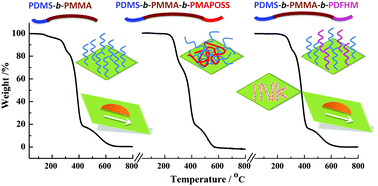An insight into the amphiphobicity and thermal degradation behavior of PDMS-based block copolymers bearing POSS and fluorinated units†
Abstract
Methacryloxypropyl-polyhedral oligomeric silsesquioxane (MAPOSS) and dodecafluoroheptyl methacrylate (DFHM) are proposed to separately block-copolymerize with polydimethylsiloxane (PDMS)-based acrylate block copolymer (PDMS-b-PMMA). The syntheses of PDMS-b-PMMA-b-PMAPOSS and PDMS-b-PMMA-b-PDFHM were executed in this manner to examine the effect of PMAPOSS and PDFHM on surface amphiphobic behavior and thermal degradation behavior. PMAPOSS and PDFHM were found to both contribute towards the improvement of static hydrophobicity. However, the PMAPOSS was found to disable the dynamic hexadecane-dewetting properties because of its restriction on molecular wriggling motion and its induced high roughness. In contrast, PDFHM was found to improve the dynamic dewetting properties for oil-based ink. With regard to the thermal stability, the incorporation of either PMAPOSS or PDFHM into PDMS-b-PMMA with PDMS (Mn ∼1000 or 5000 Da) favors the increase in the original thermal-decomposition temperature. However, the presence of PMAPOSS initiates a higher degradation rate and fails to improve the thermal stability in the case of long PDMS (Mn ∼10 000 Da) due to the heterogeneous dispersion of POSS in the matrix.



 Please wait while we load your content...
Please wait while we load your content...